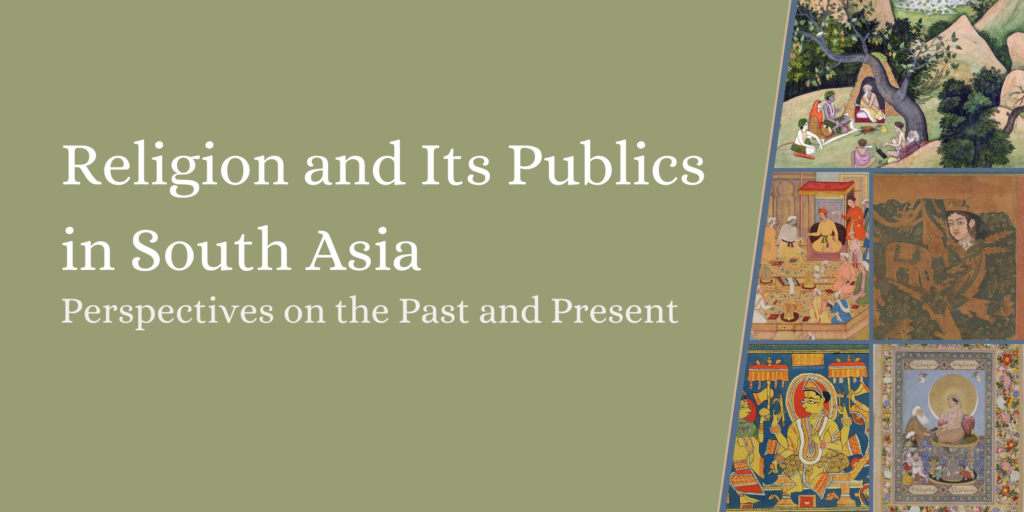
Image adapted from The Fabulous Creature Buraq by unknown author and a painting by Nar Singh (Public Domain)
A virtual conference sponsored by Canopy Forum and the Center for the Study of Law and Religion at Emory (CSLR) featuring scholars, experts and practitioners who will examine the many religious traditions of South Asia and their diverse publics. Participation by invitation only. View selected videos and browse all essays here.
“The Yemeni Breeze Longs for the Perfume of Arabia”: Remote Knowledge Exchanges in Eighteenth-Century South Asia

Daniel Morgan
In our plague-ridden times, modern technology has allowed for the exchange of knowledge over vast distances. As teachers, we have learned to commune virtually with our students in far-off cities and even continents. While we might think of these long-distance exchanges as a recent phenomenon made possible by the enchantments of the internet, even a cursory examination of letters exchanged by Muslim scholars from eighteenth century South Asia reveals that the remote transmission of knowledge has a far longer history than we might expect.
These letters, mostly written in Persian by members of the Naqshbandi, Qadiri and Chishti Sufi orders, provide us with a tantalizing snapshot into the daily lives of pre colonial South Asian intellectuals. They contain complaints of illnesses and financial worries, news of deaths and births, requests for jars of pickle (achār), rumors of invading armies, and sophisticated discussions around questions of law, philosophy and spirituality. By means of such communications, scholars living in Delhi and its hinterlands were able to stay connected with teachers, students and disciples across Hindustan (North India), Bengal, Sindh, Punjab, the Deccan (South India), Afghanistan, Arabia and Oman. But most importantly, perhaps, these letters also contain clear evidence of the routine exchange of book manuscripts between teachers and students – both edited works aimed at wider circulation and rough drafts intended for a select circle.
This is significant for historians of Muslim societies because scholars have, for many years, argued for the absolute centrality of oral knowledge transmission in Islamic educational contexts. In his recent book, Ahmed El Shamsy has outlined the received view:
In the nineteenth century, just as in the ninth or the fifteenth, Islamic religious literature was taught in circles of learning, which were held in madrasas, in mosques, or in private homes. Typically, a teacher or an assistant read out the text being taught, while students, each having either copied the text by hand before the class or bought a readymade copy produced by a professional scribe, compared their copies against the recitation, correcting any errors along the way and perhaps making marginal notes based on the teacher’s elucidation of the text.
According to such accounts, this pervasive focus on orality was based on a deep-seated suspicion of the written word and the concomitant fear that, without careful protocols for oral transmission, textual corruptions could easily creep in. Books were only given their meaning, we are told, in the context of face-to-face companionship and recitation. It was only once a student had “heard” a text that they would become links in unbroken chains of textual transmission that connected the student to the writer of the text. In such a framework, the spread of the printing press in the early nineteenth century is understood to have represented a huge epistemological rupture for Muslim societies: the easy availability of texts allowed for unguided reading and, thus, a breakdown of traditional modes of authority that led to the interpretative free-for-all of the modern period.
Although this romanticized depiction of an unchanging model of person to-person oral knowledge transmission in the pre-colonial period is not entirely without merit, the letters of our eighteenth-century Sufis reveal that it needs to be seriously qualified. In this context, scholars were perfectly willing to send, by means of messengers (qāṣids) and other intermediaries, books of all genres including apotropaic texts, books on Sufism and metaphysics, commentaries on classic texts of logic and philosophy, Quranic commentaries and even volumes of contemporary poetry. We also have evidence that vast, multi-volume collections of hadith, the genre most commonly understood to be reliant on various modes of oral/aural transmission, were being sent by mail. Although we know that oral transmission of texts was also a feature of the intellectual landscape, letters from the figures of this period demonstrate a marked disregard for the kinds of strict protocols that modern scholarship might lead us to expect. Indeed, what is noteworthy about these letters is the completely routine way in which such exchanges seem to have occurred.
How, then, do we explain this phenomenon? At one level, it is useful to think about the material conditions of the period. The eighteenth century was one of political fragmentation in South Asia and, certainly by the 1760s, travel was extremely difficult (not to mention dangerous) for Muslim scholars of North India. Letters of this period also include complaints about a decline in patronage that had previously made it possible to travel to and stay for long periods in a distant city. But we must also look to intellectual trends that played a central role in this early-modern transformation. While scholars in these networks were aware that their practices differed in certain respects from idealized classical norms, they explained what they were doing in terms of epistemological, psychological and spiritual theories that had already emerged by the late seventeenth century.
Indeed, scholars in these networks did not necessarily see these remote exchanges of knowledge as a breakdown in person-to-person transmission. Rather, they challenge the idea that person-to-person transmission relies on the physical proximity of two individuals at all. In their view, a “person” is not merely, or even primarily, a material entity bounded by a corporeal body. Decoupling the idea of personhood from bodily materiality, they argue that companionship does not necessarily require the coming together of two gross material bodies because it is, at least in its ideal form, the communion of two spirits. As a result, face-to-face companionship and letter writing were not completely distinct modes of communication but were both means for creating and invigorating bonds between the spirits (arwāh) of two individuals.
As the famous Naqshbandī polymath Shāh Walī Allāh asserts in a letter to a friend, written correspondence (mukātaba) is a kind of companionship (istihāb) or direct address (mukhātaba) that occurs despite the separation of two bodies. This transmutation was possible, he writes, because of a certain “enchantment” (nayrang) that writing produces, allowing for two spirits to commune over distance. In his view, this “enchantment” was possible because the spiritual bonds that existed between two individuals had their origin in a pre material state. Face-to-face meetings were not, in themselves, valuable except as a way to renew and strengthen these pre-material spiritual affinities. Although bodily proximity was more efficacious, epistolography was sometimes said to be superior to face-to-face companionship as an exchange of letters might make perceptible the spiritual traces of the writers while circumventing the sensuous materiality of bodies.
Walī Allāh, who lived in Delhi, captured the limitations and potentials of such exchanges in a poignant couplet that he included in a letter to his friend Muḥammd Muʿīn of Thatta who lived some 700 miles away in Sindh (modern-day Pakistan):
What need has friendship for face-to-face meeting?
The breeze of Yemen longs even now for the perfume of Arabia.
musāhabat chi zarūr ast āshnāʾī rā
hanūz bād-i yaman mahw-i nakhat-i ʿarabīst
The poem’s central conceit of a scent-bearing breeze connecting Yemen with Arabia alludes to the relationship that formed between the Prophet Muhammad and an otherwise-obscure Yemeni shepherd named Uways al-Qarnī. Although Uways longed to meet the Prophet, he felt duty bound to remain at home to look after his sick mother. Despite their physical separation, the two men developed a close spiritual connection and Uways adopted the new faith, becoming a member of the first generation of Muslims. This enigmatic bond, linking two individuals over distance, became a paradigmatic symbol for later Islamic scholars and mystics as they sought to explain how remote communications made it possible for two individuals to generate and maintain ties of friendship and trust when they were unable to meet face-to-face.
Indeed, Walī Allāh and Muḥammad Muʿīn, the recipient of this verse, only met once. Their meeting occurred in 1731, as Walī Allāh was journeying through Sindh on his way to the port of Cambay in Gujarat from whence he set sail to the Hijaz. Despite their limited time together, the two men maintained a routine exchange of letters for the next sixteen years that ended only with Muḥammad Muʿīn’s death in 1747/8. As well as exchanging news of mundane griefs and joys, Muḥammad Muʿīn would also send Walī Allāh rare books that were not easily available in Delhi but were circulating in Sindh (a region of South Asia that had long been a center for the kind of hadith scholarship that Walī Allāh favored).
Despite their increasing intellectual differences, the letters reveal a strong and sustained mutual affection. In the highly refined poetic idiom of the period, their spiritual connections were, somewhat counterintuitively, described in richly sensuous language. Indeed, such spiritual communion is often figured using precisely the kind of olfactory language that appears in the poem verse above: the mingling of the Yemeni breeze and the perfume of Arabia is meant to invoke the idea that it was possible for individuals of to “meet” over great distances, not using the apparent external senses but by means of the rarefied internal senses that allow us to experience things like love, grief, memory and imagination.
By framing their remote relationships in terms of the Prophet and Uways, the Yemeni shepherd, eighteenth-century Naqshbandīs were able to overcome their physical separation, to share knowledge and deepen their ties of trust and affection. Living in our current moment of isolation and atomization, we might perhaps learn something from these long-dead letter writers.♦
Daniel Jacobius Morgan received his BA and M.Phil. from the University of Oxford and Ph.D. from the Department of South Asian Languages and Civilizations at the University of Chicago in 2021. His research focuses on Islamic thought and Sufism in the Mughal Empire, with a specific interest in applied cosmological sciences and reformist political theology. He is currently writing an intellectual and social history of the Naqshbandi Sufis of North India in the early-modern period.
Recommended Citation
Morgan, Daniel J. “‘The Yemeni Breeze Longs for the Perfume of Arabia’: Remote Knowledge Exchanges in Eighteenth-Century South Asia.” Canopy Forum, March 14, 2022. https://canopyforum.org/2022/03/14/the-yemeni-breeze-longs-for-the-perfume-of-arabia-remote-knowledge-exchanges-in-eighteenth-century-south-asia/.

